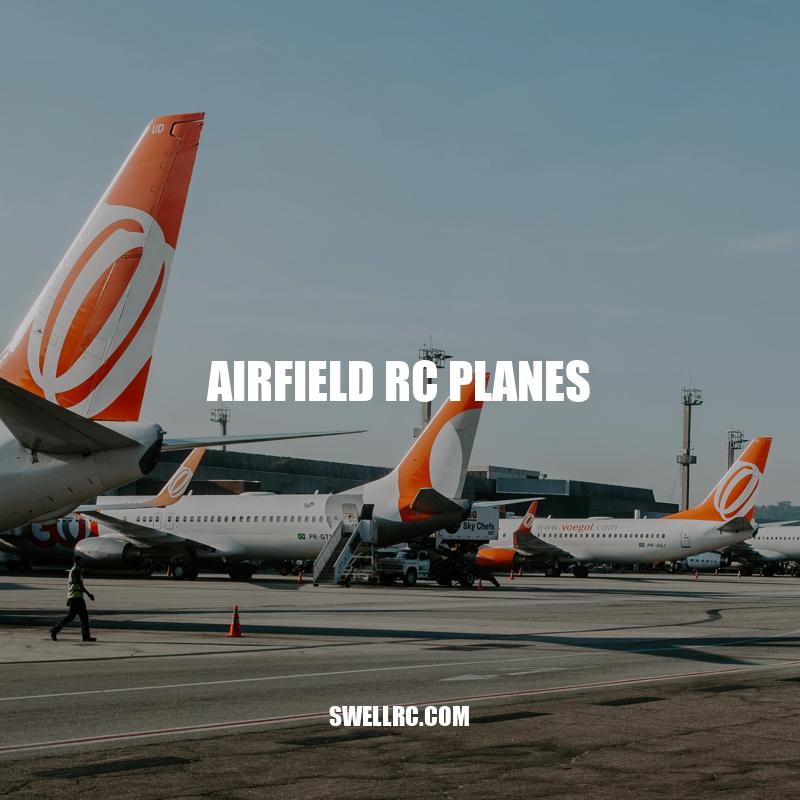Airfield RC Planes: The Ultimate Guide to Aviation Hobbyists.
If you are an aviation enthusiast looking for a new and exciting hobby, then Airfield RC planes might just be the perfect option for you. These are remote-controlled planes that come in a wide range of shapes, sizes and styles, suitable for people of all ages and skill levels. Airfield RC planes are made from lightweight materials and powered by electronic motors that operate on rechargeable batteries. You can control the movements of the planes with a wireless controller, and you can execute various stunts such as loops, spins and rolls with ease. With Airfield RC planes, you don’t have to leave the ground to soar into the skies.
The great thing about Airfield RC planes is that they are relatively affordable, easy to use, and provide a lot of entertainment. They can be enjoyed both indoors and outdoors, and depending on your experience level, you can choose from various types of planes that suit your skills. For beginners, there are training planes and gliders that are more stable and easier to control, while those more experienced can enjoy high-speed jets and modern warbirds that can perform high-speed maneuvers in the sky. Some of the popular brands in the market include E-flite, HobbyZone and FMS, and there are different assembly options such as Ready-to-Fly (RTF), Bind-and-Fly (BNF), and Plug-and-Play (PnP) that cater to different skill levels and setup preferences.
Airfield RC planes can be a relaxing and fun hobby that offers a unique experience of flying and controlling planes without actually setting foot on an airport. Whether it’s to unwind after a long day or to spend time bonding with family or friends, Airfield RC planes can provide an exciting and entertaining activity that combines technology, physics, and aviation. In the next sections of this article, we will explore more about Airfield RC planes, the different types of planes available, and the tips to get started and improve your skills. So buckle up and get ready to take off into the world of Airfield RC planes!
Different Types of Airfield RC Planes
Airfield RC planes come in a wide range of types and models. Whether you’re a beginner or an expert, there is always a plane that will suit your level of skill and experience. Some of the different types of Airfield RC planes available include:
- Trainer Plans: These are beginner-level planes that are slower and more stable, making them ideal for learners. They often come with wider wingspans and shorter flight times from their battery-operated engine.
- Glider Planes: These are versatile planes that are powered by gravity, rather than a motor. Gliders do not have engines but they can stay aloft for a long time due to their design.
- Electric Ducted Fans (EDF) Planes: These are high-performance planes that use electric motors to power their lightweight and aerodynamic designs.
- Warbirds: These are replicas of classic fighter planes used in wars such as World War II. They can be suitable for intermediate or advanced-level pilots and have a great look and performance similar to the original.
- Jet planes: These planes are high-speed top-performing and recommended for experienced RC pilots who want to soar at breakneck speeds. They are lightweight and aerodynamic to ensure they perform at a high pace.
Some popular models among Airfield RC planes include P51 Mustang, F4U Corsair, Zero A6M5, and F18 Hornet. Other search terms you can use to discover more types of planes include “Combat Planes,” “Acrobatic Planes,” and “Missile Planes.”
If you are interested in purchasing an Airfield RC plane, there are several reputable websites and online marketplace platforms where you can browse and compare products, including Amazon, HobbyKing, and Tower Hobbies. Additionally, you can consider joining online communities of other Airfield RC plane enthusiasts where you can learn more and share tips and experiences with others who are passionate about this hobby.
What is the average range of an RC plane?
Sophisticated RC plane setups are capable of achieving a range of 20-30 miles or more. To achieve such range, specialized long-range UHF control systems operating at 433 MHz (for amateur radio licensees only) or 869 MHz are commonly used. Additionally, directional, high-gain antennas can increase the video range. Visit RC plane websites or product pages to learn more about specific long-range setups.
Benefits of Airfield RC Planes
There are many benefits to choosing Airfield RC planes as a hobby. Aside from being a fun and challenging way to test your aviation skills, Airfield RC planes also offer the following benefits:
- Improves Hand-Eye Coordination: Flying an Airfield RC plane requires precise hand-eye coordination to control movements and reactions, which can help to improve your overall coordination and reflexes.
- Develops Critical Thinking Skills: Making adjustments to the plane’s settings and gauging the effects of wind and flight conditions require significant testing and thoughtful consideration to troubleshoot.
- Bonding with Family and Friends: Airfield RC planes are an excellent way to bond with friends and family members, as they offer an interactive way to learn and grow together while having fun.
- Allows Outdoor Activities: Flying Airfield RC planes is an outdoor activity that enables you to enjoy fresh air and the great outdoors while having fun and learning about aviation.
- Encourages Social Interaction: Joining online communities or attending public events around Airfield RC planes can be a chance to meet new people, find new events, and learn more about the hobby.
Did you know that RC planes have a history that long exceeds the last few decades of consumer-grade radio controllers? The controller for the first remotely-piloted aircraft was invented by Nikola Tesla in 1898 and everything since has grown from his original technology. If you want to learn more about advanced techniques and accessories, you can also find various sources for tutorials and upgrades on RC forums, sites, and other hobby landmarks.
If you are interested in purchasing an Airfield RC plane, there are several reputable websites and dedicated online marketplaces where you can find various types of RC planes, including Amazon, HobbyKing, and Tower Hobbies. You can also find starter kits, motor enhancements, and cool accessories readily available online. Moreover, you can check out the following table to compare some of the popular Airfield RC planes‘ features:
| Plane Model | Wingspan | Flight Duration | Difficulty |
|---|---|---|---|
| P51 Mustang | 1100mm | 15-20 minutes | Intermediate level |
| F4U Corsair | 800mm | 10-15 minutes | Beginner level |
| Zero A6M5 | 800mm | 13-15 minutes | Intermediate level |
| F18 Hornet | 970mm | 12-15 minutes | Expert level |
What are the advantages of RC planes?
There are several advantages of RC planes, including their ability to provide entry-level flight training, their affordability, and the excitement of controlling a miniature aircraft. RC planes also offer the opportunity to get involved in a hobby with a thriving community. If you’re interested in purchasing an RC plane, websites like Horizon Hobby and Flite Test offer a wide variety of models for different levels of experience.
Tips for Flying Airfield RC Planes
Learning to fly an Airfield RC plane takes time and patience, and it’s important to follow some rules and take precautions to ensure your safety and the safety of others. Here are a few tips to keep in mind:
- Find a Good Location: When it comes to flying an Airfield RC plane, always find an open area with plenty of space. Make sure you are at least 300 feet away from any buildings, trees, power lines, or other obstacles that could interfere with your flight.
- Pay Attention to Batteries: Always make sure your battery is charged before flying, and bring a backup battery if possible. When not in use, store your batteries in a cool, dry place away from direct sunlight or heat.
- Take Pre-Flight Safety Checks: Before you start your flight, double-check that all connections, fixtures, and components are properly secured and fastened. Check that your propeller is balanced and tightly fitted in place; any loose parts can cause sudden accidents or crashes.
- Practice Flying in Learning Mode: If your Airfield RC plane has a “learning mode,” make sure to use it while you’re practicing your basic maneuvers. These modes usually help limit the throttle or set boundaries to your plane’s range so that you can learn with ease.
- Be Aware of Your Surroundings: Always keep an eye on your plane’s position and the location of other people around you. Your Airfield RC plane may weigh a fraction of the weight of a real plane, but it could still injure a person if not handled with care.
If you’re interested in learning more about Airfield RC planes and connecting with other enthusiasts, there are several websites and online communities to explore. Websites such as RC Groups or RC Universe provide extensive forums, resources, and support for those who are just starting. They also offer advice for advanced enthusiasts, including suggestions for upgrades, reviews, and maintenance tips. Some of the most popular Airfield RC planes on these websites include Warbirds, gliders, and micro RC planes.
In case you’re worried about the cost of Airfield RC planes, many affordable models are available under $200. If you’re on a budget, consider purchasing a “plug-and-play” or DIY ARF plane kit that you can set up and modify on your own. By taking the time to do the research, investing in good equipment, and following safety guidelines, you can have a ton of fun and excitement with your Airfield RC planes.
How can I get better at flying RC planes?
To get better at flying RC planes, there are several things you can do. Start by getting a ‘throw around’ airplane that you don’t care much about. This will allow you to take risks and learn without worrying too much about crashing. Fly to crash, but also keep spare airframes on hand. Practice landing often, and fly a variety of different airplanes to gain experience. It’s also important to have enough batteries and take multiple planes to the field. Lastly, learn about aerodynamics to better understand how to control your planes. There are many great websites and products available to help improve your skills, such as RCGroups.com and Flight School by RealFlight.
Final Thoughts
Airfield RC planes are a fantastic way to explore the world of aviation in a fun, engaging, and budget-friendly way. From learning to fly basic trainers to performing advanced aerobatics with complex jets, there’s a plane for every skill level and interest. Remember to take safety precautions, practice your flying skills, and connect with the wider RC community through online forums and resources.
Overall, Airfield RC planes are an exceptional hobby that offers many benefits. They improve hand-eye coordination, creativity, and problem-solving skills while providing a relaxing and rewarding experience. With practice, you can master the art of flying and perform various tricks that will leave your audience in awe.
Whether you’re a seasoned pilot or just starting, you can unleash your creativity and passion for aviation with Airfield RC planes. So why wait? Invest in a beginner’s set and start your journey today!



